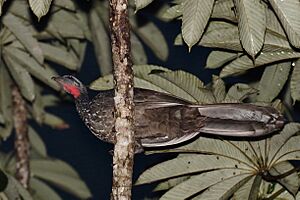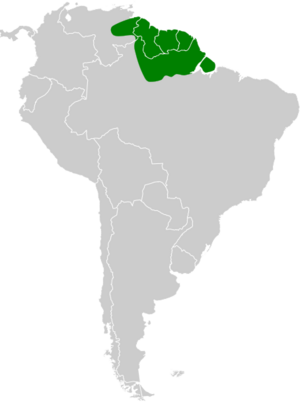Marail guan facts for kids
Quick facts for kids Marail guan |
|
|---|---|
 |
|
| Marail guan at Presidente Figueiredo, Amazonas state, Brazil | |
| Conservation status | |
| Scientific classification | |
| Genus: |
Penelope
|
| Species: |
marail
|
| Subspecies | |
|
|
 |
|
The Marail guan or Cayenne guan (Penelope marail) is a cool bird that lives in the forests of South America. It belongs to a bird family called Cracidae, which includes birds like chachalacas, guans, and curassows. You can find this bird in countries like Brazil, French Guiana, Guyana, Suriname, and Venezuela.
Contents
What Does It Look Like?
The Marail guan is about 63 to 68 centimeters (25 to 27 inches) long. That's about the length of your arm!
Male Marail guans usually weigh between 772 and 1310 grams (1.7 to 2.9 pounds). Females are a bit heavier, weighing from 770 to 1450 grams (1.7 to 3.2 pounds).
The main type of Marail guan has a dark back, wings, and central tail feathers. These parts have a shiny greenish-olive color. Its outer tail feathers are a pretty bluish-black.
Its throat and chest are dark with small white spots. The belly is a reddish-brown color. It also has a bright red dewlap, which is a flap of skin under its chin. Another type of Marail guan, called P. m. jacupeba, is a bit smaller and has a lighter, more grayish-brown color.
Where Does It Live?
The Marail guan lives in different parts of South America. The main type is found from eastern Venezuela all the way through a region called the Guianas.
The P. m. jacupeba type lives in northern Brazil, north of the Amazon River. It might also live in southeastern Venezuela.
These birds mostly live in old, grown-up tropical forests. But you can also find them in forests that have grown back after being cut down. In the Guianas and Brazil, they prefer dry, upland forests with lots of plants close to the ground. They like to stay in low-lying areas, usually between 100 and 600 meters (330 and 2,000 feet) above sea level in Venezuela.
How It Behaves
Moving Around
The Marail guan doesn't travel far from its home. It tends to stay in the same area. One study in Suriname found that their home territories were usually between 2 and 9 hectares (5 to 22 acres) in size.
What's for Dinner?
Marail guans look for food alone or in small groups of up to six birds. They usually search for food high up in the trees, in the canopy, or on lower branches. Sometimes, they even look for food on the ground.
Their diet is mostly fruits. They love to eat different kinds of fruit! Sometimes, they might also eat a few insects.
Reproduction
The time when Marail guans have their babies changes depending on where they live. In the Guianas, their breeding season seems to be from October to February. In Brazil, it might last even longer.
They build a cup-shaped nest high up in the fork of a tree. Female guans usually lay two or three eggs in their nest.
Sounds of the Marail Guan
The Marail guan makes a special wing-whirring sound, usually before the sun comes up. After this sound, they often make a barking call that sounds like "whaf, whaf, whaf." They also make these barking calls when the sun goes down.
Is It Safe?
The IUCN (International Union for Conservation of Nature) has looked at the Marail guan. They have decided that it is a species of "Least Concern." This means it's not currently in danger of disappearing.
The Marail guan is quite common in the large areas where it lives. However, like all guans, people sometimes hunt them.


